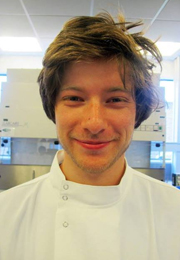Team:Exeter/Modelling
From 2013.igem.org
Tom.Hickman (Talk | contribs) |
(→The model) |
||
| Line 44: | Line 44: | ||
=== Sensor activation rate === | === Sensor activation rate === | ||
| - | |||
| + | The rule for each sensor is that it is either on or off. In the on state it catalyses the phosphorylation of the primary intermediate and in the off state it does not. Activation by light either turns a sensor on or off depending on the sensor species; the red and blue light sensors are switched off when activated while the green light sensor is switched on when activated. The activation rate is the forward rate of the rule that governs the state of a sensor. Its counterpart, the deactivation rate is the backward rate of the same rule. | ||
| + | |||
| + | The activation rate is calculated as the integral over all space of the product of the sensor's frequency response with the frequency spectrum of the incident light. | ||
| + | |||
| + | This has two important implications. Firstly it means that the sensor will not be activated by light that has no overlap between its spectrum and the frequency response of the sensor. Secondly there will be a saturation point at high intensity light where increasing the intensity will not appreciably affect the system as the activation rate will dominate the deactivation rate. Causing the sensors to be effectively permanently activated. These characteristics are faithful to the light sensitive proteins we are using and that is why we are using this method. | ||
| + | |||
| + | <!-- There are many assumptions about the action of the light sensitive protein in this calculation and they need addressing --> | ||
=== Kappa model === | === Kappa model === | ||
This subsection will explain the kappa model. How it works, the justification for its use, | This subsection will explain the kappa model. How it works, the justification for its use, | ||
Revision as of 20:57, 2 October 2013
Introduction
Our model predicts how the absorbtion spectrum of a modified E.coli changes over time in response to a given incident light spectrum. It is used to estimate key properties of our system such as stability, development time of image, the balance of colours and has three steps to its operation.
Currently the model is based on results from literature and theoretical conjecture as experimental results are not available. The motivation for the model was to numerically characterize our bio-bricks for future use and to help us create the first colour coliroid. With experimental results the model could readily be updated to fulfill its original mandate.
The Team
Physics |
Physics |
Electrical Engineering |
Modelling Software
The model uses two programs; [http://www.mathworks.co.uk/products/matlab/ MATLAB] and KaSiM combined using a batch file.
KaSiM is a [http://en.wikipedia.org/wiki/Stochastic stochastic] simulator that executes files written in [http://www.kappalanguage.org/ Kappa]. Kappa is a rule based modeling language for protein interaction networks.
MATLAB® is a high-level language and interactive environment for numerical computation, visualization, and programming. It can be used to analyze data, develop algorithms, and create models and applications.
Together they provide the necessary tools to create an accurate model of our bio-camera system.
The model
This section will go into detail about the workings of the model. Each will explain the workings of the model, the justification, the assumptions made and the advantages and disadvantages of the methodology
Sensor activation rate
The rule for each sensor is that it is either on or off. In the on state it catalyses the phosphorylation of the primary intermediate and in the off state it does not. Activation by light either turns a sensor on or off depending on the sensor species; the red and blue light sensors are switched off when activated while the green light sensor is switched on when activated. The activation rate is the forward rate of the rule that governs the state of a sensor. Its counterpart, the deactivation rate is the backward rate of the same rule.
The activation rate is calculated as the integral over all space of the product of the sensor's frequency response with the frequency spectrum of the incident light.
This has two important implications. Firstly it means that the sensor will not be activated by light that has no overlap between its spectrum and the frequency response of the sensor. Secondly there will be a saturation point at high intensity light where increasing the intensity will not appreciably affect the system as the activation rate will dominate the deactivation rate. Causing the sensors to be effectively permanently activated. These characteristics are faithful to the light sensitive proteins we are using and that is why we are using this method.
Kappa model
This subsection will explain the kappa model. How it works, the justification for its use,
Absorbtion spectrum
This subsection will explain how the absorbtion spectrum of the cell is calculated and justify the method.
Results
This section will list in detail the results of our model
Analysis
This section will contain what the data means
Conclusions
This section will contain our conclusions about the model
Future
This section will contain our opinions about the future of the model
 "
"







